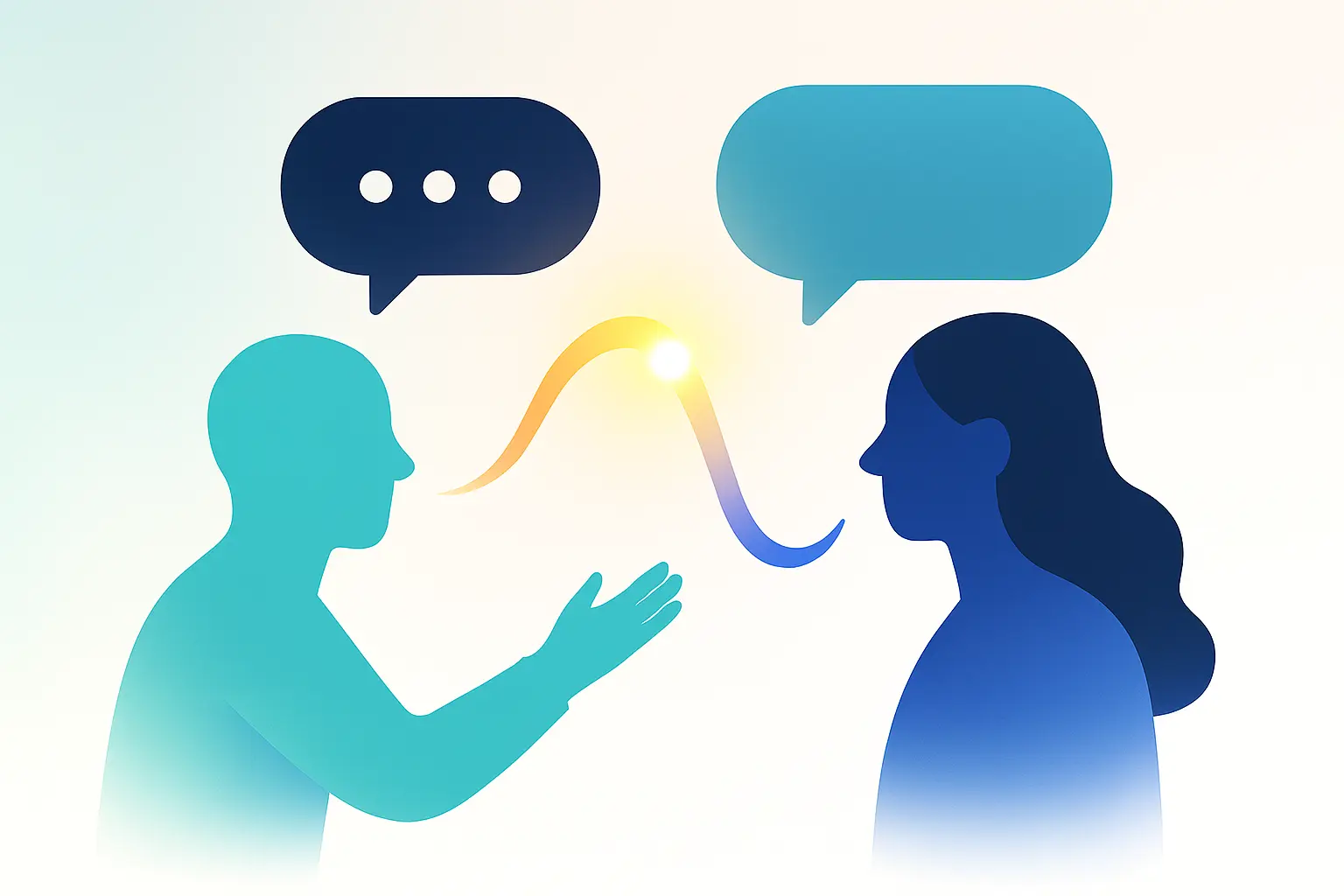Sales Funnel – Stages, Examples, Template and How to Build One
- July 6, 2023
- 14 mins read
- Listen

Understanding a customer’s buying journey is key for a business to optimize the sales process and enhance customer experience. It’s also essential for building long-term relationships and ensuring value to customers at each stage of the journey. For that reason, a sales funnel becomes important as it helps marketers understand a customer’s buying journey and also know the stage/s of the journey in regard to customers.
Based on the insights from a sales funnel, a business can decide the best marketing channels and activities to guide customers toward a purchase. By using a sales funnel, marketers are better able to optimize their messaging and boost conversions.
This shows how companies have traditionally been using a sales funnel where the premise is to fill the top of the funnel with prospects and convert those who reach the bottom. Since buyer’s journey is not simple anymore as they don’t always follow a linear path, the sales funnel approach may need a detailed study to best understand a buyer’s journey.
In this blog, we will explore the sales funnel, its definition, the stages and examples, and steps to create one for your business.
But first, let’s get started with understanding the definition of a sales funnel…
What is A Sales Funnel?
A sales funnel is a conceptual framework that represents the customer’s journey from the awareness to the final purchase stage. The purpose of creating a sales funnel is to visualize the stages potential customers take to complete the conversion process. A sales funnel consists of several stages, which vary from industry to industry and as per the specific sales model of each company.
Each stage of the sales funnel represents a different level of customer intent and engagement. When sales funnels are developed without any gap, they prove very helpful for businesses to guide their customers through the buying process towards purchase. On the other hand, gaps in a sales funnel may witness potential customers dropping out of the sales process.
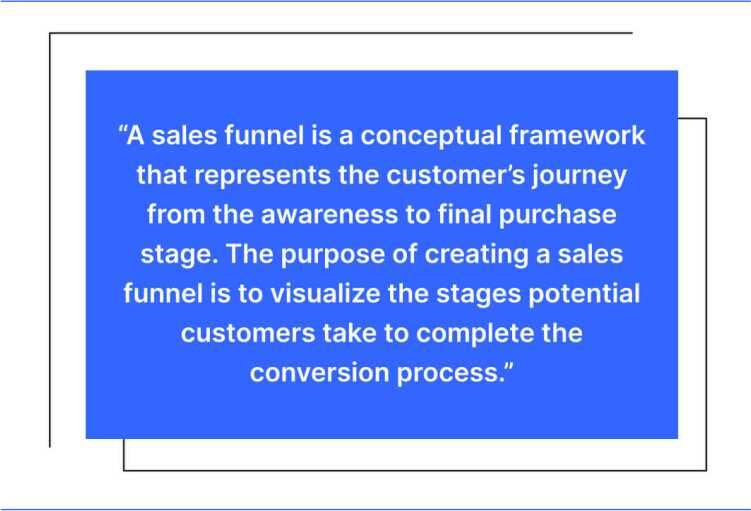
At the top of the funnel, there is the ‘Awareness Stage” followed by the “Consideration Stage”. The “Decision Stage” is when prospects evaluate the company’s offerings. In the final stage, “Purchase” or conversion happens.
Using the sales funnel concept, a business not only understands the customer journey better but can also identify the potential drop-off points. The funnel is also key to optimizing marketing and sales strategies based on identifying the areas of improvement. When the efforts are aligned with each stage of the sales funnel, a business can maximize the chances of converting prospects into customers.
Why is the Sales Funnel Important?
The importance of a sales funnel is big in terms of helping businesses understand the customer journey in detail. Without the sales funnel, no business can streamline its marketing and sales processes, resulting in substandard results.
By contrast, conversion rates can be improved and customer experience enhanced when a business understands the sales funnel better. Despite that, 68% of companies don’t measure their sales funnel.
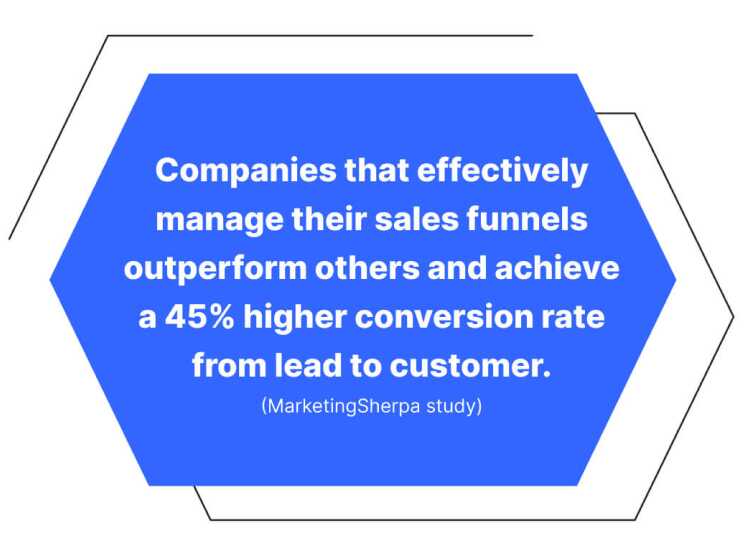
Here are the key reasons why the sales funnel is important –
- Customer journey visualization – A sales funnel for e-commerce gives a visual representation of the customer’s journey from the very beginning to the final purchase. It offers a broad understanding of the steps and stages that potential customers take, so businesses can align their sales and marketing efforts accordingly.
- Drop-off points identification – An analysis of the sales funnel can give ideas about the areas that are causing potential customers to drop off mid-way without completing the journey. When a business is aware of the drop-off points, it could plug the gap with improved sales and marketing strategies and efforts.
- Resource optimization – A sales funnel gives the knowledge of the stages that are performing well and that need some attention. Based on this information, a business can optimize its resources accordingly and boost the rate of conversion.
- Customer’s pain-points knowledge – When customers are not happy, chances are they might lose interest and drop off at some points on their journey before completing the purchase. A business can leverage the sales funnel to know the pain points of customers and take steps to improve their overall experience.
- Conversion rate improvement – A business can implement the right strategies and tactics only when it’s aware of the customer’s experience within the sales funnel and its various stages. This knowledge can help it provide value at each stage, resulting in improved chances of conversions.
The Stages in the Sales Funnel
A sales funnel is a fluid and dynamic concept where the funnel can vary in size and shape from industry to industry and company to company. Since the sales funnel is not linear, it may have five or six stages with customers moving back and forth between stages.
By understanding these stages, a business can meet customers’ needs and optimize conversion rates. For that reason, around 5 out of ten marketers prioritize the improvement of their sales funnel.
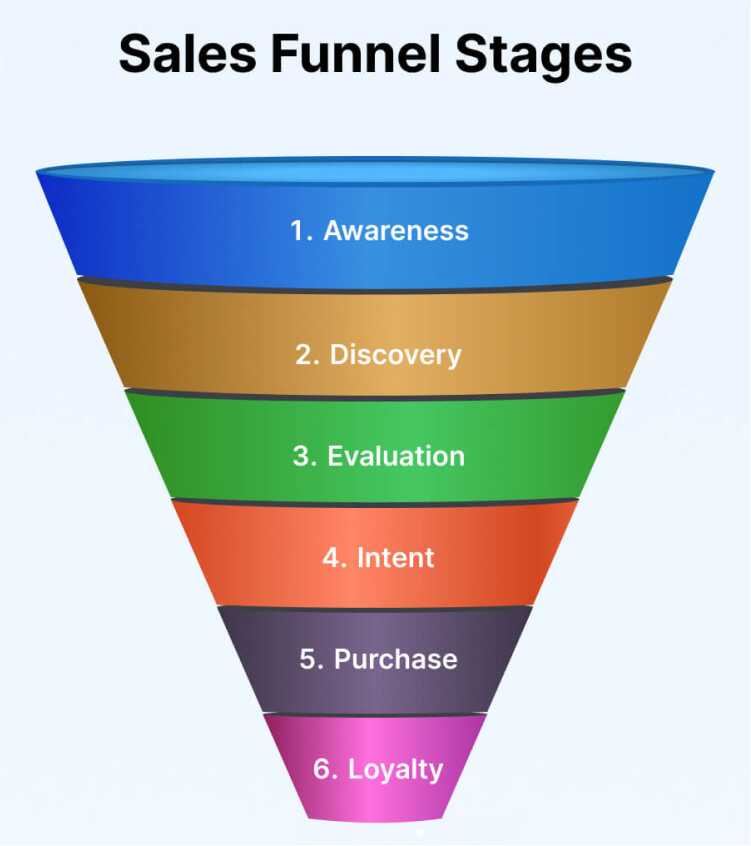
Here are the stages in the sales funnel –
- Awareness – This stage sits at the very top of the sales funnel and it concerns the situation when potential customers become aware of the brand. In the awareness stage of the funnel, a business will have the largest number of prospects who are aware of the brand but may not necessarily convert later on.
- Consideration – When customers become aware of the brand and their offerings, the next step for them is to show interest or consider the brand. In showing interest, they might need more information, browse your website, read the blog, go through the reviews, or engage with the content.
- Evaluation – By the time potential customers reach the “Evaluation” stage, they are already aware of your offers and have compared your offerings to competitors. They now evaluate whether your products and services can meet customer needs. From reaching out to the customer support team to filling out the form to requesting demos or trials, this stage may witness steps that may feel like coming from potential customers.
- Negotiation – When customers reach this stage, it shows they have made up their minds to purchase your product or avail of your service. So, naturally, being a customer, they might open a negotiation over the price, terms, or both and a business needs to handle customers with great care at this stage.
- Conversion – This is the stage when prospects either make a purchase or take a similar action that is equivalent to sales. Since customers have decided to purchase with your business, the focus should be on ensuring a seamless buying experience by removing all the friction and simplifying the entire buying process.
- Retention – The conversion stage is not the end of a sales funnel as no business would ideally like not to get repeat purchases. In this stage, the goal is to encourage repeat purchases and retain the customer. Some of the key activities at this stage include prompt customer support, onboarding, up and cross-selling.
How to Build a Sales Funnel?
Building a sales funnel is easy when you know about your prospects, leads, and customers. With a sales funnel, you can identify and harvest quality leads over and again. It will also help you engage with your prospects in a timely and relevant manner.
The steps to building a sales funnel include –
Step 1 – Define Your Target Audience
A good sales funnel is the result of a deep understanding of your target audience. The better you know your existing customers, the more effective your sales funnel can be. So, the first step in building a sales funnel is to identify and define your target audience. Then next, you need to understand their interests, pain points, and motivations. Once you have the demographics data as well, you can tailor the sales funnel and engage with the right audience.
Key Strategies
- Collect as much customer data as you could by communicating with your customers.
- Track customer interactions with your various channels.
- Create an ideal customer persona based on the data you have collected.
- Focus on presenting the right messaging at the right time to engage with the right people.
Step 2 – Create Awareness and Captivate Your Audience
Creating awareness about your business and products is key when your focus is to gain customer attention and captivate them. Without their attention, you may not be able to get them into the sales funnel. So, you need to take an effort in engaging, interacting, and entertaining the audience using a mix of strategies and content for getting their attention. You need to communicate with customers in an effective manner.
Key Strategies
- Use engaging content with the purpose to inform and educate your audience, and also to solve their problems
- Devise a proper content marketing plan where you produce a variety of content types such as videos, blog posts, infographics etc. for catering to your audience’s needs.
- Increase the visibility of your content and website so that prospective customers can easily find them through search engines.
- Use paid ads on popular platforms such as social media and search engines to increase the reach of your presence.
- Engage with your audience on the choice of their social media platforms and boost interactions through discussions and post sharing.
Step 3 – Capture Leads
Once you have created awareness, the next step is to make an impression and guide your prospects to a place where they can see your offerings and get their needs met. You basically need to make concrete plans to capture leads by using clear call-to-action. This is how you can take the prospects further down the funnel. To capture leads, you will need contact data like contact information and email.
Key Strategies
- Create a landing page that clearly communicates your company and the value proposition it offers to prospects.
- Seek contact details in exchange for valuable resources such as ebooks, templates, and whitepapers
- Use opt-in forms in a strategic manner on your blog, website, or social media pages so that visitors feel encouraged to subscribe to your newsletter or email list.
Step 4 – Nurture Leads
Now when you have captured leads, you are in the middle of the funnel where the key is to build relationships and nurture the leads. The goal is to keep the prospects engaged, inform them about your offers and help them how your products and services are solutions to their needs. Only this could convince and encourage your leads to get converted into paying customers. Rather than using over-the-top sales and product pitches, in this stage, the key is to find ways and use tactics that inspire and not force leads to become customers.
Key Strategies
- Create a powerful email campaign to educate, and guide leads through the buying process.
- The email should be personalized so that it can cater to the specific needs and motivations of the leads and inform them about the value of your offers.
- Keep the leads engaged with a well-devised drip campaign that is triggered at a specific time or on specific actions.
- Use the power of re-marketing to get back to those leads that once showed some interest but dropped out of the funnel.
Step 5 – Convert Leads
Now the leads are ready to be converted and you need to devise and implement a set of strategies for this bottom stage of the sales funnel. The key is to highlight the features and benefits of your product or service so that leads feel encouraged to buy. Apart from creating compelling landing pages, you should also focus on tailoring offers in tune with the leads’ preferences and behavior.
The CTA you use on various touchpoints needs to encourage leads into taking the desired action rather than forcing them out of the funnel. It’s equally important to do a quick and personalized follow-up when an interest is shown in your product or service.
Step 6 – Follow Up And Aim for Retention
Customers stay in the sales funnel long after buying your products or services. They don’t move out or drop out and having paid for your offerings has made them stick with you either directly or indirectly. So, you’d naturally want them to come back and buy more. For that reason, follow-up is important.
Key Strategies
- Provide support to your customers so that any issue they have could be addressed timely and promptly.
- Seek customer feedback on a regular basis to understand their problems and issues.
- Make a strategy for customer delight and retention like you can implement loyalty programs.
H2 – Sales Funnel Template
A sales funnel can help your team a lot in visualizing the step required to close deals. Since each industry is unique, sales funnels too won’t come with one-size-fit all. A business can customize it to its needs and empower its marketing and sales team.
Here are some sales funnel template examples for different industries –
1. SaaS Sales Funnel Template
The sales funnel for SaaS will also start with using various measures and steps to make prospective customers aware of your product. Emails, online ads, and marketing are some of the ways to create awareness of the product.
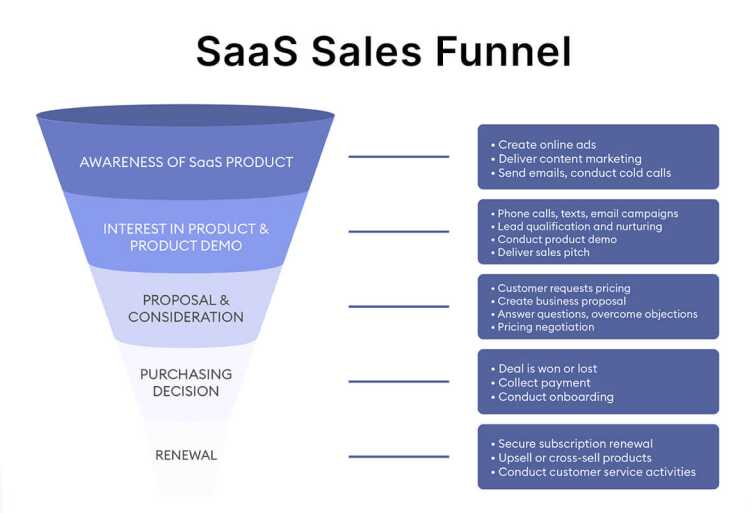
The next stage is to follow up with the leads to nurture and qualify them. Customers will consider the product when there are sales pitches and a proposal with pricing. The last stage of the SaaS sales funnel is the most valuable as here customers often consider renewal options and may, or may not, renew.
2. E-Commerce Sales Funnel Template
An ecommerce sales funnel template can prove very helpful in driving conversions and maximizing sales. In this funnel, the awareness stage involves a combination of content marketing, SEO, and social media promotions to engage with the audience. The use of paid ads, landing pages, and lead magnets forms the core of the acquisition stage. In the nurture stage, brands need to send personalized emails, product recommendation emails, abandoned cart emails, and retargeting ads. The key to the conversation stage is to ensure product descriptions and have an easy check-out process.
3. B2B Sales Funnel Template
Business-to-business, or B2B, services sales funnels look similar to most other funnels but they differ a bit in terms of the interest stage. Here, sales reps need to focus more on educating and informing prospective customers about the benefits of their products and services.
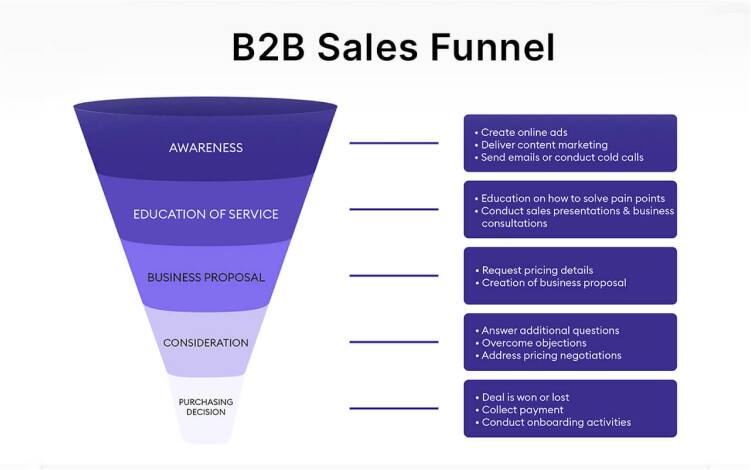
In the next stage, a proposal is created so that the prospective customer may have a look at the key terms and things before considering a purchase. After that, a negotiation happens before the final purchase decision.
Sales Funnel Example 1 – Apple
Apple uses various channels to create brand awareness and let people know about it. It makes use of online and TV ads and also does smart placements in TV shows and movies. Its demo videos and product reviews are the main elements of arousing interest in potential customers. The company provides detailed product info, comparisons, and customer testimonials on its site to influence buyers in the consideration stage. More so, Apple gives the option to buy either online through the website or any physical store.
Sales Funnel Example 2 – Nike
Nike does impact marketing campaigns to create brand awareness. It sponsors big events and collaborates with athletes. Plus, its social media marketing is renowned for brand awareness purposes. Aware customers visit Nike’s website to explore the latest collections and also watch its videos of products. The company not only offers detailed product information but also lets people customize its products, compare and read reviews before making a purchase decision. Online stores and physical retail outlets are there for purchase.
Final Thoughts
A business can optimize the sales process steps and boost customer experience only when it has a complete understanding of the buyer’s journey. It’s also key to building long-term relationships by ensuring value at each stage of the journey.
With REVE Chat, you can find a range of quality tools for boosting customer engagement and customer experience. These tools could help you add value to your customer journey.
You can sign up here and see how our tools can prove value addition to your sales funnel process.


